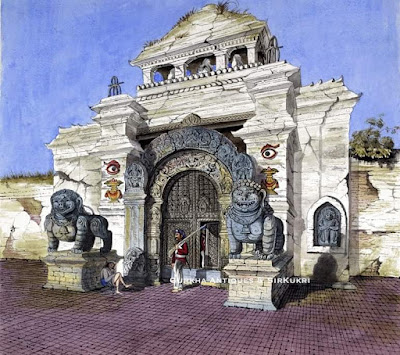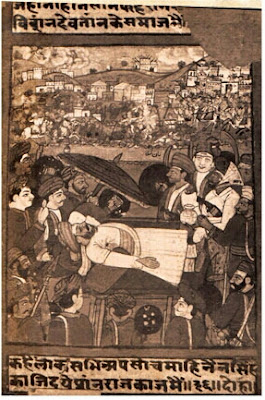Prologue
Jung Bahadur knew from his forebears the story of how the Kunwars along with other martial clans arrived in the hills of Nepal. Kunwar was a title given to princes from the Kingdom of Mewar comprising the much storied Udaipur, Chittorgarh and other princely states of Rajputana. The rulers enjoyed the title of 'Rana' and "Maharana" depending on the size of the state. They had given a tough fight to Islamic conquerors of India. However, during the period of the Delhi Sultanate in early 14th Century, the cruel ruler Alauddin Khilji marauded the Mewar Kingdom with wanton disregard to human suffering. He eventually conquered Chittorgarh in 1303 A.D. His court historian has written that 30,000 Hindus were slaughtered during this campaign. When the men went out to fight bravely and perished, the women committed a form of sati called Jauhar, the tradition of group self-immolation by fire, so they may not be abused by the conquering Islamic hordes. This is the historicity behind the Bollywood movie Padmavati.
It was during this period that the ruling families of Mewar fled the kingdom and made it to the safety of the remote foothills of the Himalaya, far away from the reach of the Muslim conquerors of Northern India. The family of Kunwar Kumbhakarna Singh, younger brother of King Ratna Singh of the Sisodia clan of Mewar was one of the many that fled the carnage. Kumbhakarna stayed behind to fight but made arrangements for his family to leave Rajputana. With good fortune on their side they took refuge in today's Kaski district of Nepal. Over a period of time they became known as Kunwars, their princely title and lineage all but forgotten and reduced to a mere surname. They were given high military posts and jagirs by the local Rajas. The descendants of these first refugees Ratan Singh Kunwar and his son Ahiram Singh Kunwar both served the Raja of Kaski.
West and mid-west Nepal then had various clan fiefdoms of 22 feudatories in the West and 24 feudatories in the Mid-west constantly bickering and fighting among themselves. Some of them were ruled by indigenous tribes and others by the Chettry or "tagadhari" Hindus who wore the sacred thread in their bodies, whose forebears had themselves run away from the Hindu states of India from the early 14th Century onward. The Raja of Kaski asked for the hand of Ahiram's beautiful daughter in a morganatic marriage but Ahiram repulsed this advance and said that he would agree only to a true Hindu wedding. Ahiram Singh Kunwar did not feel safe in Kaski anymore and left for the Kingdom of Gorkha to present himself to the court of King Prithivi Narayan Shah with his two sons Ram Krishna Kunwar and Jaya Krishna Kunwar. Recognizing their military and administrative prowess King Prithivi Narayan gave them land grant "birta" of the Kunwar Khola where they settled. Ram Krishna Kunwar rose in the military ranks and by the time of the unification of Nepal he was one of the important military generals of the Gorkha Kingdom.
 |
| Ram Krishna Kunwar |
Sardar Ram Krishna Kunwar played a big role in the conquest of Kathmandu Valley. Firstly, King Prithivi Narayan Shah instructed Ram Krishna to set out to conquer Makwanpur to the south so that no relief could come to the Malla kings of Kathmandu Valley from the south. The Nawab of Bengal Mir Kasim sent his forces in the command of Gurgin Khan to rebuff the Gorkhalis but they were soundly beaten. The southern passes secured, secondly the king sent instructions to impose a strict blockade of the valley to essential goods such as salt, grain, and cotton. (Stiller, Rise of House of Gorkha, pages 122-123). During the final assault Ram Krishna Kunwar was stationed at Balaju fortress that he had built and along with commanders from various other garrisons stormed Kathmandu City on the day of Indra Jatra and entered the city from the Simha-Dhoka victorious. (Daniel Wright, History of Nepal page 287).
 |
| Simha Dhoka sketch by Henry Ambrose Oldfied 1858 A.D. |
After 1769 A.D. following the victory over Kathmandu valley, he started expansion eastward crossing the Dudhkosi and establishing new boundary at River Mechi. He died on 21st March 1771 in Puthana where he was setting up an arsenal. There is a story that when King Prithivi Narayan Shah asked to name his reward for his achievements, he only requested for the road between Pashupatinath and Gujeshwori to be paved at his own cost! (Padma Jung, Life of Jung Bahadur)
Kathmandu Valley now under Gorkha control, King Prithivi Narayan Shah made Nuwakot Durbar his abode. During the time of his grandson King Rana Bahadur Shah's minority reign, Prithivi's second son Regent Bahadur Shah continued the expansion of the Gorkha Kingdom both eastward and westward. Ram Krishna Kunwar was stationed in Jumla where he died. His son Ranjit Kunwar was made the Subbah of Jumla district at the age of 21. After successful campaigns in Kumaon and Garhwal he was made a Kazi, one of the four in the Gorkha Kingdom.
Gorkha expansion westward was further initiated by Prime Minister Bhimsen Thapa in 1805 A.D. during the minority reign of King Girvana Yuddha Bikram Shah under the regency of Queen Mother Tripura Sundari. Under the command of General Amar Singh Thapa decision was taken to cross the Sutlej River and take Kot Kangra in the domain of Sansar Chand, a Rajput of Katoch dynasty. The fort was taken with great difficulty. Both the grandfathers of Prime Minister Jung Bahadur Rana perished in this campaign: his paternal grandfather Kazi Ranjit Kunwar, at 58 years of age, was shot in the chest while scaling the wall of the fort and his maternal grandfather Kazi Nain Singh Thapa, the younger brother of Prime Minister Bhimsen Thapa, was also mortally wounded by a bullet and died a few days later. Aided by the Punjabi Army of Maharajah Ranjit Singh, Sansar Chand regained the vital fort at Kangra and the Gorkhalis had to remove themselves from the territory west of the Sutlej River in 1806 A.D. The west-ward expansion of Nepal had come to a screeching halt!
 |
| Death of Kazi Nain Singh Thapa |
Bal Narsingh Kunwar (1783 - 1842 A.D.) was the son of Ranjit Kunwar. With the advent of King Rana Bahadur Shah's rule, dramatic events took place in the court. Smitten by a beautiful Maithili Brahmin widow Kantavati he went against religious norms and the court's advice and married her and made her son Girvana Yuddha the Crown Prince of Nepal superseding his rightful heir Ranodyat Shah, son of his second Queen Subarna Prabha. After the death of Kantavati with smallpox, not convinced that his will would be carried out by the court, he abdicated the throne and crowned Girvana and decided to leave for Benaras as a mendicant in 1799 A.D. A relatively unknown Sardar Bhimsen Thapa and his family members including Bal Narsingh Kunwar accompanied the king in his retirement. Bhimsen was the head of the king's bodyguard. During this period the war hero of the Tibetan campaigns and son of King Prithivi Narayan Shah's military chief Kalu Pandey, Kazi Damodar Pandey became the mukhtiyar wielding power with the baby king Girvana Yuddha on the throne.
Bal Narsingh spent five years with the king in Benaras until his return in 1804 A.D. at the head of a military force to take back the power in Nepal. He was successful in his mission and put to death Damodar Pandey who was leading the state's opposition to his return. Bhimsen Thapa became the leading nobleman from this period. Ex-king Rana Bahadur made himself the mukhtiyar in 1806 A.D. much to the concern of the court that had not forgotten nor forgiven his erratic behavior earlier. His own half-brother Sher Bahadur Shah came to blows with him during an altercation and struck him dead. At this time the 23 year old soldier Bal Narsingh came into prominence; he acted with bravery and confronted Sher Bahadur and cut him down with his sword. Following this assassination Bhimsen became Mukhtiyar and rewarded Bal Narsingh Kunwar with the tile of Kazi.
 |
| Kazi Bal Narsingh Kunwar |
Bal Narsingh was given important assignments in Nepal from Dhankuta to Dandeldhura and finally to Jumla as Governor, a post his father and grandfather had held before him. Bal Narsingh had married a second time and his eldest son from this marriage was born in 1817 A.D. in Thapathali in his wife's home and was named Bir Narsingh Kunwar. It was an important time of learning for the boy moving from place to place with his father and getting to know the country well. He was commissioned in the army as a second lieutenant in 1835 A.D. Bir Narsingh Kunwar would one day become known famously in history as Jung Bahadur Rana of Nepal.
Epilogue
King Surendra Bikram Shah conferred on Jung Bahadur and his brothers and their progeny the tile of "Rana" harking back to their Rajput heritage in 1848 A.D. After the successful conclusion of the war with Tibet in 1856 A.D. and the great victory of the Gokhali forces in Lucknow during the Indian Mutiny of 1857 A.D. King Surendra Bikram Shah bestowed on Jung Bahadur the hereditary title of Maharajah of Kaski and Lamjung. The family of Jung Bahadur was now equal to the Shah kings of Nepal to foster matrimonial ties.





Very insightful
ReplyDeleteI have a passing passion on nepali history. The blogs i read here are great. Please post more if you feel readers deserve more.
ReplyDelete
ReplyDeleteVery nicely presented for posterity. The plot twists are amazing. Human behavior continues to be so fascinating and you tell a good story
Keep writing
Buddha Basnyat
The picture/painting that you have posted of Kazi Ranjit Kunwar, is actually of Kazi Abhiman Singh Basnyat. A simple Google search would confirm this.
ReplyDeleteBest regards!